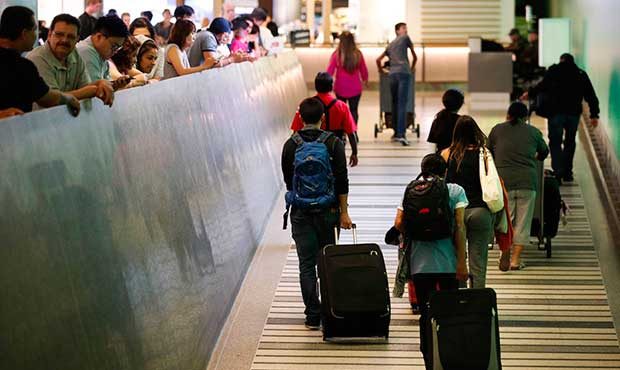Legally Speaking: Clearing up questions about Trump’s travel ban
Jul 18, 2017, 4:45 AM | Updated: Jul 19, 2017, 3:07 pm

Travelers make their way up the arrival ramp at the Tom Bradley International Terminal at the Los Angeles International Airport Thursday, June 29, 2017, in Los Angeles. (AP Photo/Jae C. Hong)
(AP Photo/Jae C. Hong)
On Sunday, The Agenda co-host Joe Huizenga and I were discussing the status of President Donald Trump’s travel ban and, based on the response from listeners, I realized that there is considerable confusion about what is going on.
This is understandable considering all the legal wrangling that has taken place. To understand the status of the travel ban, you have to study and digest all the different orders issued by the eight courts that have been involved.
Or you can keep reading.
Let’s break down the case by date and what each court has decided before I sum it up for you:
• Jan. 27: Trump issued his executive order banning entry into the U.S. by citizens from seven different countries and stopping all refugees.
• Jan. 28: U.S. District Court Judge Ann Donnelly in New York issued an injunction stopping enforcement and implementation of part of the travel ban.
• Jan. 29: U.S. District Court Judge Allison Burroughs in Massachusetts issued a temporary retraining order stopping enforcement of part of the travel ban.
• Feb. 2: Trump eases restrictions related to green card holders.
• Feb. 3: U.S. District Court Judge Nathaniel Gordon in Massachusetts did not renew the temporary restraining order originally issued by Burroughs on Jan. 29.
• Feb. 3: U.S. District Court Judge James Robart in Washington enjoins enforcement of part of the travel ban.
• Feb. 5: The 9th Circuit Court of Appeals refuses Trump’s request to resume the ban.
• Feb.9: After briefs and argument, a three-judge panel of the 9th Circuit Court of Appeals refuses to reinstate the travel ban.
• March 6: Trump issues a revised travel ban (or, as I call it, travel ban 2.0) that reduces it to six countries and removes visa and green card holders.
• March 15: U.S. District Court Judge Derrick Watson issues a nationwide order that enjoins and blocks enforcement of travel ban 2.0.
• March 16: U.S. District Court Judge Theodore Chuang in Maryland blocks a part of travel ban 2.0.
• March 29: Watson extends the time for the barring of travel ban 2.0.
• March 30: Trump appeals Watson’s ruling to the 9th Circuit Court of Appeals.
• May 8: The 4th Circuit Court of Appeals begin to hear an appeal of travel ban 2.0.
• May 25: The 4th Circuit Court of Appeals blocked travel ban 2.0.
• June 26: The Supreme Court accepts the case to be heard in its fall term and rules Trump’s ban on visitors from the six countries can be enforced if those visitors lack a “credible claim of a bona fide relationship with a person or entity in the United States.”
• July 13: Watson expands the definition of a “bona fide relationship” to include other family members, such as grandparents.
• July 14: Trump files a motion in the Supreme Court asking it to block Watson’s July 13 order.
• July 18: The Supreme Court requests Hawaii respond to the Department of Justice’s appeal of Watson’s July 13 order.
• July 19: The Supreme Court leaves Watson’s order in place that expanded the definition of bona fide relationship to include grandparents and others.
By my count, the above means that at least eight different courts have been involved in this legal battle and issued more than 12 orders, all a bit different from each other. It takes a legal statistician to keep all this straight!
Where does travel ban 2.0 stand now? Trump’s ban on visitors from Iran, Libya, Somalia, Sudan, Syria and Yemen can be enforced if those visitors lack a “credible claim of a bona fide relationship with a person or entity in the United States.”
That bona fide relationship includes parents, grandparents, grandchildren, aunts, uncles, nieces, nephews, finances, and parents/brothers/sisters-in-law.
An interesting question came in from a KTAR listener that shows just how confusing this legal quagmire has become. The question was, “How can a federal district court overrule the Supreme Court?”
This is a great question because, upon first glance, that is exactly what it looks like the judge in Hawaii did. However, Watson simply interpreted what he believed the Supreme Court meant when it ruled there must be a bona fide relationship.
You see, the Supreme Court gave us an answer but not a bright line rule. It gave us the bona fide relationship language but it did not define what that is.
This created another avenue for interpretation, discretion, subjectivity and confusion.
I would like to say that this confusion will all end when the Supreme Court issues its ruling in the fall or early winter. However, it could give us yet another avenue that keeps this legal wheel spinning.
For now, travel ban 2.0 is in effect, although it may not actually ban anyone.









